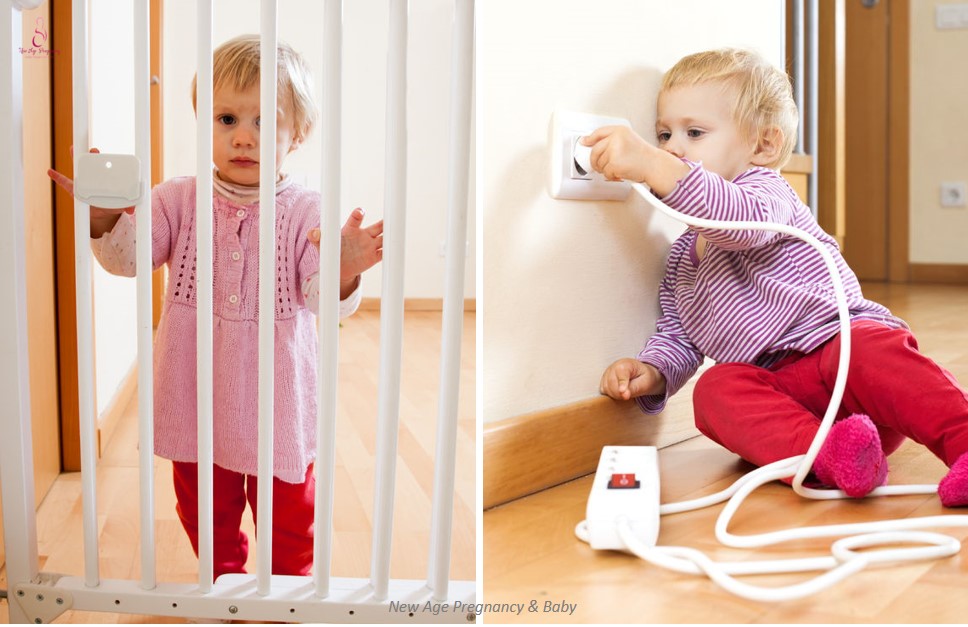
For young children, the risk of injury often comes from falls, choking, poisoning, burns and drowning. Childproofing your house becomes an important factor in caring for your child. How can you make your home safe and secure for your child? Here are the top 10 tips on childproofing your home!
Childproof Tip #1 – Get a Baby’s Eye View
From an adult’s view, there may not be much danger or accident-prone areas at home. However, things can look very different from your crawling baby’s view. If you get down on your knees and move about, you may suddenly notice that the electricity outlet is right in your face beside many sharp corners you could bump into, or the household tools that were kept in lower cabinet look dangerously like a toy and pose as potential danger to your explorer. As your child grows older, look again around your house at his/her height. You might spot and remove a potential risk.
Childproof Tip #2 – Bumper that Corner
Bumping into corners of tables is a common accident for a child. Get bumpers for all corners and if you’re designing your house for babies. It is best to choose furniture without sharp corners and which you won’t cringe if the bumpers left a mark after removal.
Childproof Tip #3 – Cover the Outlets
All electrical outlets should be covered and you can choose those with sliding safety latch. Make sure the plug-in caps you choose are not easily removed and become a choking hazard. Drawers should be closed and installed with safety latch too.
Childproof Tip #4 – Gate it
Your crawling baby or toddler probably has no business in the kitchen. Install safety gates where you don’t want your child to go. If you are choosing a safety gate that works with pressure clamps instead of requiring holes to be drilled, make sure that the gates themselves are secure and will not fall off.
Childproof Tip #5 – Put Danger away
Children will not know that something should not be consumed nor played with, thus keep items below out of reach:
– Detergent and chemicals
– Flammable liquids
– Medicines
– Sharp objects like knife, pen knife, letter opener and scissors
– Tools
– Pot handles or hot objects should be kept out of reach and the former, turned inward
– Trash cans
Childproof Tip #6 – The tiny ones
Babies who are learning to crawl are also exploring the world around them. Very likely, anything on the floor (even lizard poop!) may be of interest to them. Be sure that paper clips, loose staples, buttons, coins or safety pins are not on the floor.
Childproof Tip #7 – Coil it
Electrical wires may trip a child or if it’s too long, be a strangulation hazard. Likewise for curtain cords. Be sure that these are either in protective casing or safely coiled and out of reach from the child.
Childproof Tip #8 – No Topple
Adults don’t pull the entire bookshelf when using it, but children are likely to climb on the shelves, which could toppling the entire shelf over. Television and other furniture which may tipped over should be secured to the wall. Place heavier items below to reduce risk of toppling over.

Childproof Tip #9 – Off the window
Avoid placing furniture near the window, especially a chair or stool where the child can climb and look out. As children have a higher centre of gravity, it is easy for them to tip over and fall off. Never encourage a child to climb on a chair and look out of the window.
Childproof Tip #10 – Practice Water Safety
Never leave water in the bath tub nor leave a child unattended in one. Toilet seat cover should have a safety latch to avoid the child from falling in. For washing machine, always switch it off (and unplug if necessary) to avoid a child pressing and starting a washing cycle, and being in it! Keep all electric appliances away from water to avoid electric shock.
While childproofing your home is important, child supervision is critical. No matter how safe your home is, your young child should always be supervised – of course, a childproofed home makes your job easier and safer!
Written by Mei






